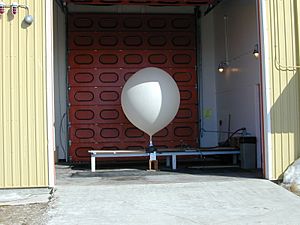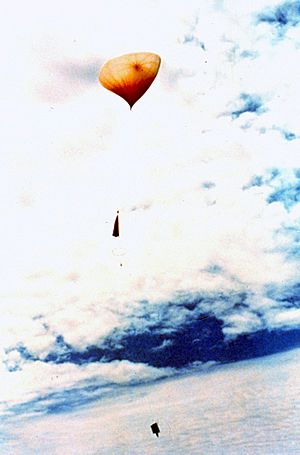Weather balloon facts for kids

A weather balloon is a special type of balloon that flies high into the sky. It carries small tools to collect information about the atmosphere. These tools measure things like atmospheric pressure (how much the air pushes down), temperature (how hot or cold it is), and humidity (how much water vapor is in the air). The main tool it carries is called a radiosonde, which sends all this information back to people on the ground.
To find out about wind data, these balloons can be tracked using radar, radio signals, or even satellite systems like GPS. Weather balloons were a big step in "remote sensing," which means gathering information from far away without people being there. They are super important for studying our atmosphere.
The History of Weather Balloons
The idea of using balloons to check the weather started a long time ago. The very first observation balloon was launched on November 21, 1783. It was sent up just before the first human balloon flight in France to see which way the wind was blowing.
Later, a French meteorologist named Leon Teisserenc de Bort (1855-1913) really pushed for using weather balloons. He showed how useful they were. With the information from his balloons, he discovered a lower part of the atmosphere. He called it the troposphere, or "sphere of change," because that's where all our weather happens!
Since the 1930s, when radio tracking was invented, weather balloons became even more advanced. They turned into complete floating weather stations. They could carry tools like thermometers (for temperature), barometers (for pressure), hygrometers (for humidity), and even cameras and telescopes.
How Weather Balloons Help Us
Many weather groups use weather balloon flights to understand the atmosphere better. This helps them make more accurate weather predictions. They collect information like temperature, pressure, and humidity. This data can then be put onto weather maps.
Weather balloons can also help create 3D models of the atmosphere. This is because the tools they carry collect data from many different heights. Since they first started, these long bags of helium have been carrying more and more advanced observation devices. They literally take the science of weather observation to the very edge of outer space!
Images for kids
-
Picture taken at approximately 30 km above Oregon using a 1,500 gram weather balloon
-
Rawinsonde weather balloon just after launch. It has a parachute and a small instrument box. It measures temperature, relative humidity, pressure, and wind speed and direction. This information is sent back to people on the ground.
See also
 In Spanish: Globo meteorológico para niños
In Spanish: Globo meteorológico para niños





